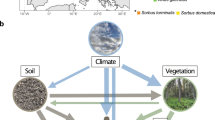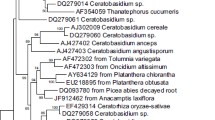Abstract
Dark septate endophytes (DSE) are root-associated fungi that inhabit plant roots and soil in a wide variety of ecosystems and host plants worldwide. They are recognized by their distinctive growth habit inside healthy roots, although the taxonomic and functional variety of the fungi forming the associations is high. DSE fungi have the potential to act as beneficial symbionts of the trees and other plants, but the evidence is unequivocal. They grow in the roots together with mycorrhizal- and other root-associated fungi, but the relationships between these fungal groups are unknown. Boreal and subarctic forests constitute a continuous belt in the cool and cold areas of the Northern Hemisphere. Roughly, boreal forests are characterized by coniferous trees. The subarctic is most distinctive in the Northernmost Europe where mountain birch (Betula pubescens ssp. czerepanovii) forests form a continuous forest cover near the Arctic treeline. In this chapter, information from studies on DSE fungi in the boreal and subarctic forests is compiled and discussed.
Access this chapter
Tax calculation will be finalised at checkout
Purchases are for personal use only
Similar content being viewed by others
Abbreviations
- ITS:
-
Internal transcribed spacer
- AFLP:
-
Amplified fragment length polymorphism
- RFLP:
-
Restriction fragment length polymorphism
- PAC:
-
Phialocephala fortinii s.l. – Acephala applanata group
References
Addy HD, Hambleton S, Currah RS (2000) Distribution and molecular characterization of the root endophyte Phialocephala fortinii along an environmental gradient in the boreal forest of Alberta. Mycol Res 104:1213–1221
Addy HD, Piercey MM, Currah RS (2005) Microfungal endophytes in roots. Can J Bot 83:1–13
Ahlich K, Sieber TN (1996) The profusion of dark septate endophytic fungi in non-ectomycorrhizal fine roots of forest trees and shrubs. New Phytol 132:259–270
Barrow JR, Aaltonen RE (2001) Evaluation of the internal colonization of Atriplex canescens (Pursh.) Nutt. roots by dark septate fungi and the influence of host physiological activity. Mycorrhiza 11:199–205
Bent E, Kiekel P, Brenton R, Taylor DL (2011) Root-associated ectomycorrhizal fungi shared by various boreal forest seedlings naturally regenerating after a fire in interior Alaska and correlation of different fungi with host growth responses. Appl Env Microbiol 77:3351–3359
Björbäkmo MFM, Carlsen T, Brysting A, Vrålstad T, Hoiland K, Ugland KI, Geml J, Schumacher T, Kauserud H (2010) High diversity of root associated fungi in both alpine and arctic Dryas octopetala. BMC Plant Biol 10:244
Blaalid R, Davey ML, Kauserud H, Carlsen T, Halvorsen R, Høiland K, Eidesen PB (2014) Arctic root-associated fungal community composition reflects environmental filtering. Mol Ecol 23:649–659
Bodeker ITM, Lindahl BD, Olson Å, Clemmensen KE (2016) Mycorrhizal and saprotrophic fungal guilds compete for the same organic substrates but affect decomposition differently. Funct Ecol 30:1967–1978
Caldwell BA, Jumpponen A, Trappe JM (2000) Utilization of major detrital substrates by dark-septate, root endophytes. Mycologia 92:230–232
Currah RS, Van Dyk M (1986) A survey of some perennial vascular plant species native to Alberta for occurrence of mycorrhizal fungi. Can Field Nat 100:330–342
DeBellis T, Kernaghan G, Bradley R, Widden P (2006) Relationship between stand composition and ectomycorrhizal community structure in boreal mixed-wood forest. Microb Ecol 52:114–126
Grünig CR, Sieber TN (2005) Molecular and phenotypic description of the widespread root symbiont Acephala applanata gen. et sp. nov. formerly know as dark-septate endophyte Type 1. Mycologia 97:628–640
Grünig CR, Duò A, Sieber TN, Holdenrieder O (2008) Assignment of species rank to six reproductively isolated cryptic species of the Phialocephala fortinii s.l.—Acephala applanata species complex. Mycologia 100:47–67
Hambleton S, Currah RS (1997) Fungal endophytes from the roots of alpine and boreal Ericaceae. Can J Bot 75:1570–1581
Harney SK, Rogers SO, Wang CJK (1997) Molecular characterization of dematiaceous root endophytes. Mycol Res 101:1397–1404
Haselwandter K (1979) Mycorrhizal status of ericaceous plants in alpine and subalpine areas. New Phytol 83:427–431
Haselwandter K (1987) Mycorrhizal infection and possible ecological significance in climatically and nutritionally stressed alpine plant communities. Angew Botanik 61:107–114
Haselwandter K, Read DJ (1980) Fungal associations of dominant and sub-dominant plants in high-alpine vegetation systems with special reference to mycorrhiza. Oecologia 45:57–62
Haselwandter K, Read DJ (1982) The significance of root-fungus association in two Carex species in high-alpine plant communities. Oecologia 53:352–354
Hashiba T, Narisawa K (2005) The development and endophytic nature of the fungus Heteroconium chaetospira. FEMS Microbiol Ecol 252:191–196
Hengodage NBW, Ruotsalainen AL, Markkola A, Häggman H (2017) Root fungal colonisations of the understory grass Deschampsia flexuosa after top-canopy harvesting. Plant Soil 414:171–180
Huusko K, Tarvainen O, Saravesi K, Pennanen T, Fritze H, Kubin E, Markkola A (2015) Short.term impacts of energy wood harvesting on ectomycorrhizal fungal communities of Norway spruce saplings. ISME J 9:581–591
Huusko K, Ruotsalainen AL, Markkola AM (2017) A shift from arbuscular mycorrhizal to dark septate endophytic colonization in Deschampsia flexuosa roots occurs along primary successional gradient. Mycorrhiza 27:129–138
Jepsen JU, Hagen SB, Ims RA, Yoccoz NG (2008) Climate change and outbreaks of the geometrids Operophtera brumata and Epirrita autumnata in subarctic birch forest: evidence of a recent outbreak range expansion. J Anim Ecol 77:257–264
Jumpponen A (2001) Dark septate endophytes—are they mycorrhizal? Mycorrhiza 11:207–211
Jumpponen A, Trappe JM (1998) Dark-septate root endophytes: a review with special reference to facultative biotrophic symbiosis. New Phytol 140:295–310
Jumpponen A, Mattson KG, Trappe JM (1998) Mycorrhizal functioning of Phialocephala fortinii: interactions with soil nitrogen and organic matter. Mycorrhiza 7:261–265
Jumpponen A, Herrera J, Porras-Alfaro A, Rudgers J (2017) Biogeography of root-associated fungal endophytes. In: Tedersoo L (ed) Biogeography of mycorrhizal symbiosis. Springer International Publishing, pp 195–222
Karst J, Erbilgin N, Pec GJ, Cigan PW, Najar A, Simard SW, Cahill JF Jr (2015) Ectomycorrhizal fungi mediate indirect effects of a bark beetle outbreak on secondary chemistry and establishment of pine seedlings. New Phytol. https://doi.org/10.1111/nph.13492
Kauppinen M, Raveala K, Wäli PR, Ruotsalainen AL (2014) Contrasting preferences of arbuscular mycorrhizal and dark septate fungi colonizing boreal and subarctic Avenella flexuosa. Mycorrhiza 24:171–177
Kernaghan G, Patriquin G (2011) Host associations between fungal root endophytes and boreal trees. Microb Ecol 62:460–473
Kernaghan G, Patriquin (2015) Diversity and host preference of fungi co-inhabiting Cenococcum mycorrhizae. Fungal Ecol 17: 84–95
Knapp DG, Kovács GM, Zajta E, Groenewald JZ, Crous PW (2015) Dark septate endophyte pleosporalean genera from semiarid areas. Persoonia 35:87–100
Lahlali R, McGregor L, Song T, Gossen BD, Narisawa K, Peng G (2014) Heteroconium chaetospira induces resistance to clubroot via upregulation of host genes involved in jasmonic acid, ethylene, and auxin Biosynthesis. PLoS ONE 9:e94144
Lazaruk LW, Macdonald SE, Kernaghan G (2008) The effect of mechanical site preparation on ectomycorrhizae of planted white spruce seedlings in conifer-dominated boreal mixedwood forest. Can J For Res 38:2072–2079
Lehtonen J, Heikkinen K (1995) On the recovery of mountain birch after Epirrita damage in Finnish Lapland, with a particular emphasis on reindeer grazing. Ecoscience 2:349–356
MacDonald GM, Gajewski K (1992) The northern treeline of Canada. In: Janelle D G (ed) Geographical snapshots of North America. Guilford Press, pp 34–37
Mahmoud RS, Narisawa K (2013) A new fungal endophyte, Scolecobasidium humicola, promotes tomato growth under organic nitrogen conditions. PLoS ONE 8:e78746
Mandyam K, Jumpponen A (2005) Seeking the elusive function of the root-colonizing dark septate endophytes. Stud Mycol 53:173–189
Mayerhofer MS, Kernaghan G, Harper KA (2013) The effects of fungal root endophytes on plant growth: a meta-analysis. Mycorrhiza 23:119–128
Menkis A, Allmer J, Vasiliauskas R, Lygis V, Stenlid J, Finlay R (2004) Ecology and molecular characterization of dark septate fungi from roots, living stems, coarse and fine woody debris. Mycol Res 108:965–973
Narisawa K, Hambleton S, Currah RS (2007) Heteroconium chaetospira, a dark septate root endophyte allied to the Herpotrichiellaceae (Chaetothyriales) obtained from come forest soil samples in Canada using bait plants. Mycoscience 48:274–281
Newsham KK (2011) A meta-analysis of plant responses to dark septate root endophytes. New Phytol 190:783–793
Newsham KK, Upson R, Read DJ (2009) Mycorrhiza and dark septate endophytes in Polar Regions. Fungal Ecol 2:10–20
Olsrud M, Carlsson BÅ, Svensson BM, Michelsen A, Melillo JM (2010) Responses of root fungal colonization, plant cover and leaf nutrients to long-term exposure to elevated atmospheric CO2 and warming in a subarctic birch forest understory. Global Change Biol 16:1820–1829
Piercey MM, Graham SW, Currah RS (2004) Patterns of genetic variation in Phialocephala fortinii across a broad latitudinal transect in Canada. Mycol Res 108:955–964
Poosakkannu A, Nissinen R, Kytöviita M-M (2015) Culturable endophytic microbial communities in the circumpolar grass, Deschampsia flexuosa in a sub-Arctic inland primary succession are habitat and growth stage specific. Environ Microbiol Rep 7:111–122
Porras-Alfaro A, Bayman P (2011) Hidden fungi, emergent properties: endophytes and microbiomes. Annu Rev Phytopathol 49:291–315
Postma JWM, Olsson PA, Falkengren-Grerup U (2007) Root colonisation by arbuscular mycorrhizal, fine endophytic and dark septate fungi across a pH gradient in acid beech forests. Soil Biol Biochem 39:400–408
Queloz V, Sieber TN, Holdenrieder O, McDonald BA, Grünig CR (2011) No biogeographical pattern for a root-associated species complex. Glob Ecol Biogeogr 20:160–169
Read DJ, Haselwandter K (1981) Observations of the mycorrhizal status of some alpine plant communities. New Phytol 88:341–352
Reininger V, Grünig CR, Sieber TN (2012) Host species and strain combination determine growth reduction of spruce and birch seedlings colonized by root-associated dark septate endophytes. Env Microbiol 14:1064–1076
Rodriquez RJ, White JF Jr, Arnold AE, Redman RS (2009) Fungal endophytes, diversity and functional roles. New Phytol 182:314–330
Ruotsalainen AL, Markkola AM, Kozlov MV (2007) Root fungal colonisation in Deschampsia flexuosa: effects of pollution and neighbouring trees. Environ Poll 147:723–728
Ruotsalainen AL, Markkola AM, Kozlov MV (2010) Birch effects on root fungal colonisation of crowberry are uniform along different environmental gradients. Basic Appl Ecol 11:459–467
Saravesi K, Aikio S, Wäli PR, Ruotsalainen AL, Kaukonen M, Huusko K, Suokas M, Brown SP, Jumpponen A, Tuomi J, Markkola A (2015) Moth outbreaks alter root-associated fungal communities in subarctic mountain birch forests. Microb Ecol 69:788–797
Sieber TN (2007) Endophytic fungi in forest trees: are they mutualists? Fungal Biol Rev 21:75–89
Sieber TN, Grünig CR (2013) Fungal root endophytes. In: Eshel A, Beeckman T (eds) Plant roots—the hidden half. Boca Raton, FL, USA. CRC Press, Taylo & Francis Group, 38.1–38.49
Smith SE, Read DJ (2008) Mycorrhizal symbiosis, 3rd edn. Academic Press, London
Stoyke G, Currah RS (1991) Endophytic fungi from the mycorrhiza of alpine ericoid plants. Can J Bot 69:347–352
Stoyke G, Egger K, Currah RS (1992) Characterization of sterile endophytic fungi from the mycorrhizae of subalpine plants. Can J Bot 70:2009–2016
Summerbell R (2005) Root endophyte and mycorrhizosphere fungi of black spruce, Picea mariana, in a boreal forest habitat: influence of site factors on fungal distributions. Stud Mycol 53:121–145
Taylor DL, Herriott IC, Stone KE, McFarland JW, Booth MG, Leigh MB (2010) Structure and resilience of fungal communities in Alaskan boreal forest soils. Can J For Res 40:1288–1301
Tejesvi MV, Ruotsalainen AL, Markkola AM, Pirttilä AM (2010) Root endophytes along a primary successional gradient in northern Finland. Fungal Divers 41:125–134
Tejesvi MV, Sauvola T, Pirttilä AM, Ruotsalainen AL (2013) Neighboring Deschampsia flexuosa and Trientalis europaea harbor contrasting root fungal endophytic communities. Mycorrhiza 23:1–10
Terhonen E, Keriö S, Sun H, Asiegbu FO (2014) Endophytic fungi of Norway spruce roots in boreal pristine mire, drained peatland and mineral soil and their inhibitory effect on Heterobasidion parviporum in vitro. Fungal Ecol 9:17–26
Upson R, Read DJ, Newsham KK (2009) Nitrogen form influences the response of Deschampsia antarctica to dark septate root endophytes. Mycorrhiza 20:1–11
Usuki F, Narisawa K (2007) A mutualistic symbiosis between a dark septate endophytic fungus, Heteroconium chaetospira, and a nonmycorrhizal plant, Chinese cabbage. Mycologia 99:175–184
Väre H, Vestberg M, Eurola S (1992) Mycorrhiza and root-associated fungi in Spitsbergen. Mycorrhiza 1:93–104
Author information
Authors and Affiliations
Corresponding author
Editor information
Editors and Affiliations
Rights and permissions
Copyright information
© 2018 Springer International Publishing AG, part of Springer Nature
About this chapter
Cite this chapter
Ruotsalainen, A.L. (2018). Dark Septate Endophytes (DSE) in Boreal and Subarctic Forests. In: Pirttilä, A., Frank, A. (eds) Endophytes of Forest Trees. Forestry Sciences, vol 86. Springer, Cham. https://doi.org/10.1007/978-3-319-89833-9_5
Download citation
DOI: https://doi.org/10.1007/978-3-319-89833-9_5
Published:
Publisher Name: Springer, Cham
Print ISBN: 978-3-319-89832-2
Online ISBN: 978-3-319-89833-9
eBook Packages: Biomedical and Life SciencesBiomedical and Life Sciences (R0)




